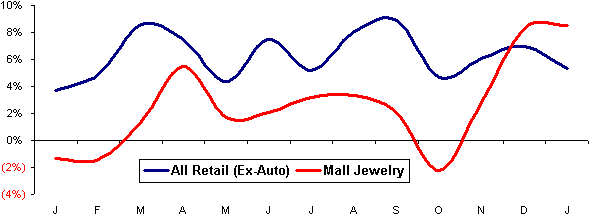IDEX Online Research: Positive Outlook for Canadian Jewelers in ‘06
March 23, 06
Canadian jewelry sales remained strong in January 2006, continuing a trend that was established in the all-important 2005 holiday selling season. Mall-based Canadian jewelers posted a very strong 8.5 percent sales gain in January, following an 8.3 percent gain in December.
Mall-based merchants (all retail categories) saw their sales rise 6.1 percent in January on top of a 5.2 percent gain in December. StatCanada reported that January sales for all of Canada’s retailers (except auto sales) rose 5.3 percent in January, and rose a strong 7.0 percent in December. Thus, Canadian jewelers gained market share, when compared to other retail categories.
The graph below summarizes sales trends for Canadian retailers (ex-auto) and Canadian mall-based jewelers.
| Retail Sales Trends - Canada |
Solid Retail Sales Trends
While there has been some month-to-month cyclicality in retail sales, consumer demand has remained consistently steady and strong since the beginning of 2005. Jewelry retailers have seen more sales volatility, but overall jewelry sales gains have been solid on an annual basis.
According to StatCanada, Canadian shoppers increased their spending in virtually all retail sectors in January, with the exception of food and beverages. New car sales also rebounded. The strongest retail sectors in January were furniture, home furnishings, consumer electronics, miscellaneous stores, building and outdoor home supplies stores, and general merchandise retailers.
The category of “miscellaneous stores”, which consists of sporting goods as well as hobby, music, and book stores, benefited from consumers redeeming gift cards. Consumer electronics retailers also benefited from gift card redemption.
There were four key factors which drove retail sales in January 2006 in Canada:
- Strong economic fundamentals – Together with the popularity of gift cards, strong economic fundamentals were the foundation for strong retail sales in January.
- Unseasonably warm temperatures – Normally, January is the coldest month of the year, and Canadians stay indoors to keep warm. However, with warmer-than-normal temperatures, Canadian consumers ventured out into the malls.
- Increasing observance of certain religious and cultural holidays – Between Kwanza and other cultural holidays that extend into January, consumers had reason to continue their spending habits.
- Housing activity – Housing starts were very strong in 2005. There is a corollary effect on furniture and home furnishings demand after homes are built.
Retail Sales Widespeard
Retail sales were up in every Canadian province and territory in January. Aside from Ontario, Alberta and British Columbia were the largest contributors to retail sales growth.
The government of Alberta gave out $400 personal rebates in January; this had a major impact on consumer demand. Retail sales in Alberta have been rising sharply since 2000, benefiting from the energy resources boom. Alberta’s average personal disposable income has grown by 7.0 percent for the past five years, significantly higher than the national average growth of 4.6 percent.
Outlook
Total Canadian employment increased by 0.2 percent in February for the second month in a row. The unemployment rate fell by 0.2 percentage points to 6.4 percent, matching the 30-year low set in November 2005.
Housing starts dropped 2.9 percent in February, but remain strong. Auto demand decreased slightly in February.
Based on these and other trends, it is likely that Canadian jewelers will enjoy another year of solid sales gains.
